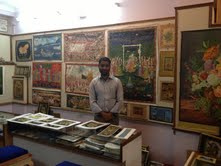Contribute
| In Conversation With Arif Shaikh, Miniature Artist |
01/14/2013
Seated on a thick flat pillow with a low wooden desk serving as an easel of sorts, Arif Shaik is a miniature artist of the Mewar school. He is one of the 17 artists at The ‘Real Art’ academy, an institution well known in Udaipur. Tourists flocking to Udaipur make a visit to the center and Lonely Planet guide defines it as must see destination point. Miniatures are the most famous among paintings developed under the patronage of various Rajput rulers. The art still continues, though with considerably less patronage, in places like Nathwara, Udaipur and Bikaner, although most paintings made now are copies of old originals. Arif Shaik comes from a family of artists. Unable to get a proper education due to lack of resources and money, he started to learn the art very early by watching the senior artists. Today he takes on the unofficial role of explaining the intricacies of the art form to the curious visitor. We are immediately struck when he shows us a few paintings of Radha and Krishna. These are beautiful, finely-drawn paintings with rich detailed patterns and striking bold colors. Other examples that he shows are paintings that portray hunting scenes which are painted on cloth and archaic paper using stone colors. One painting that is very popular depicts a beautifully adorned camel, a horse and an elephant all in on one. “They always go together, Arif says as they depict good luck, fame and valor, which were the hallmark of the Rajput rulers. In the earlier days the paintings were done on walls and one sees this reflected in the frescoes of old palaces. The tradition of painting the wall of houses with scenes from mythological and stories of bravery has been prevalent in Rajasthan for the past many centuries. Later on rulers hired artists to make portraits. Portraits of kings and rulers provide information about their lifestyle,costume and pursuits although sometimes exaggerated . The Rajasthani style of Indian miniatures was created for the Rajput emperors. Speaking in excellent English, Arif explains that he had no formal schooling. His command of the language came when he was compelled to explain his art to various international visitors. With the help of language books he know speaks both English and French. He proceeds to give us a demonstration; The entire process is described, including the method of drawing, painting, making colors and making brushes. Learning to make the squirrel-hair brushes is part of these early lessons on materials. Miniature painting is an individualized process. Gold was used extensively in text illumination, in paintings and in borders of manuscripts. Certain details of jewellery, the armor and even the finer aspects of clothing were all painted in gold. Thin sheets of gold foil were pounded and mixed with gum Arabic to form a paste. Arif says that colors used are all from the minerals that are brought from the forest. These organic and mineral sources are mixed with a gum before they are applied. The artists take a break in the winter months since many the paintings take time to dry and the cold deters that process. The art takes a toll on the artists as years of bending and painting these intricate art form affects their eyesight and their backs. Today Arif explains, that they are able to survive thanks to the patronage of a few global foundations . The minimum price of the paintings range from Rs 2000 to a few lakhs.†It is a passion that keeps us going, not the money†he says, giving is a glimpse of the miniature artists’ life.
You may also access this article through our web-site http://www.lokvani.com/
